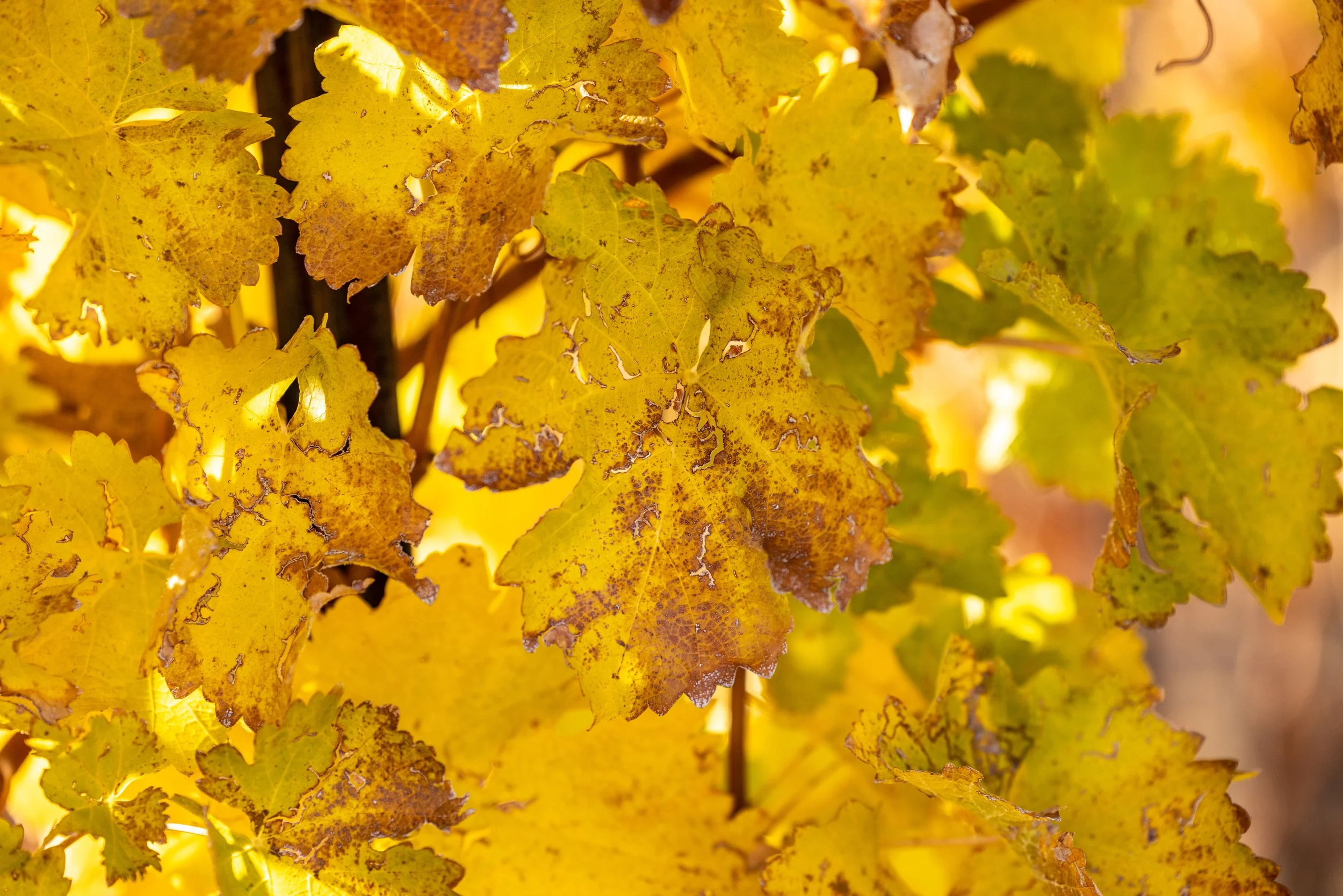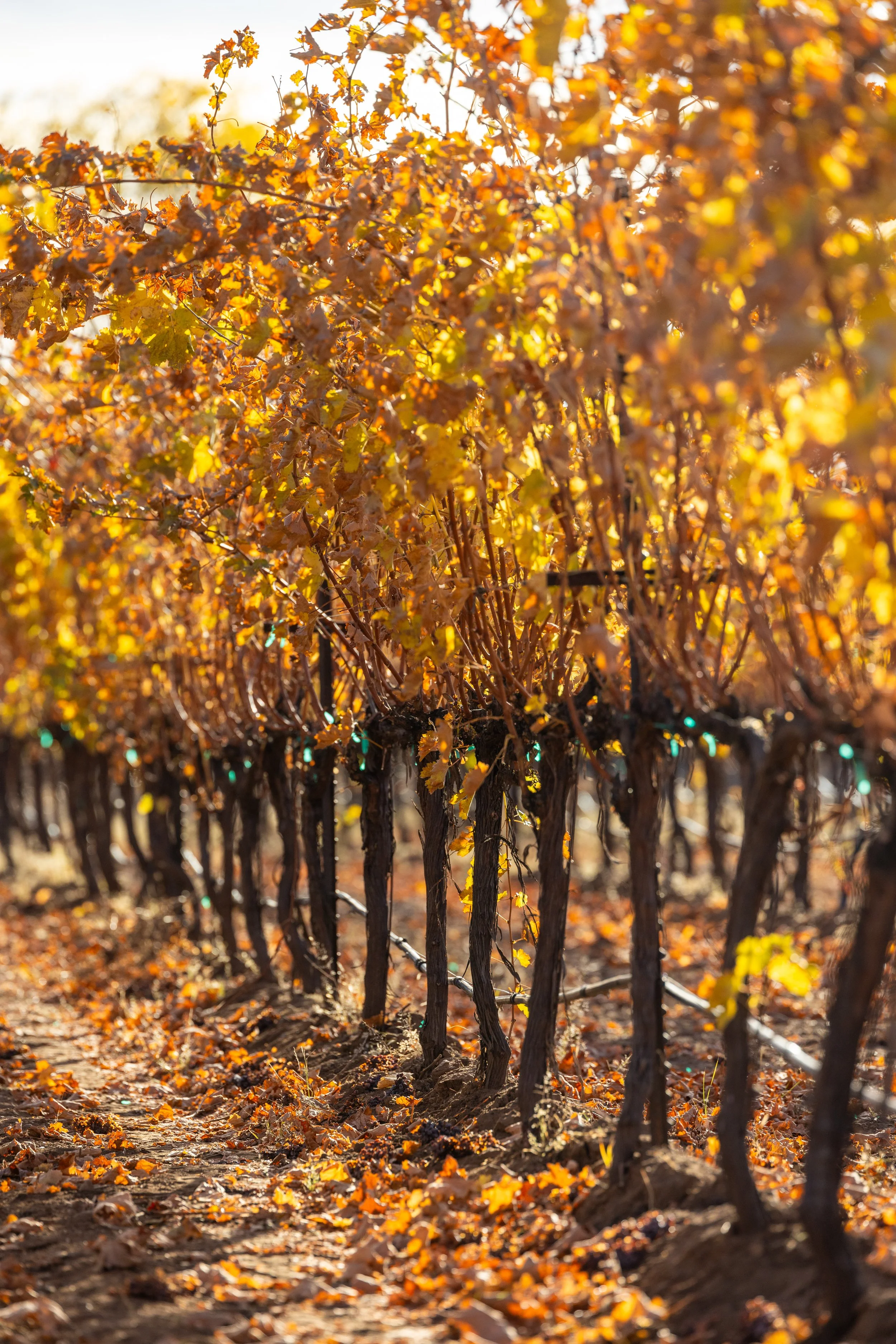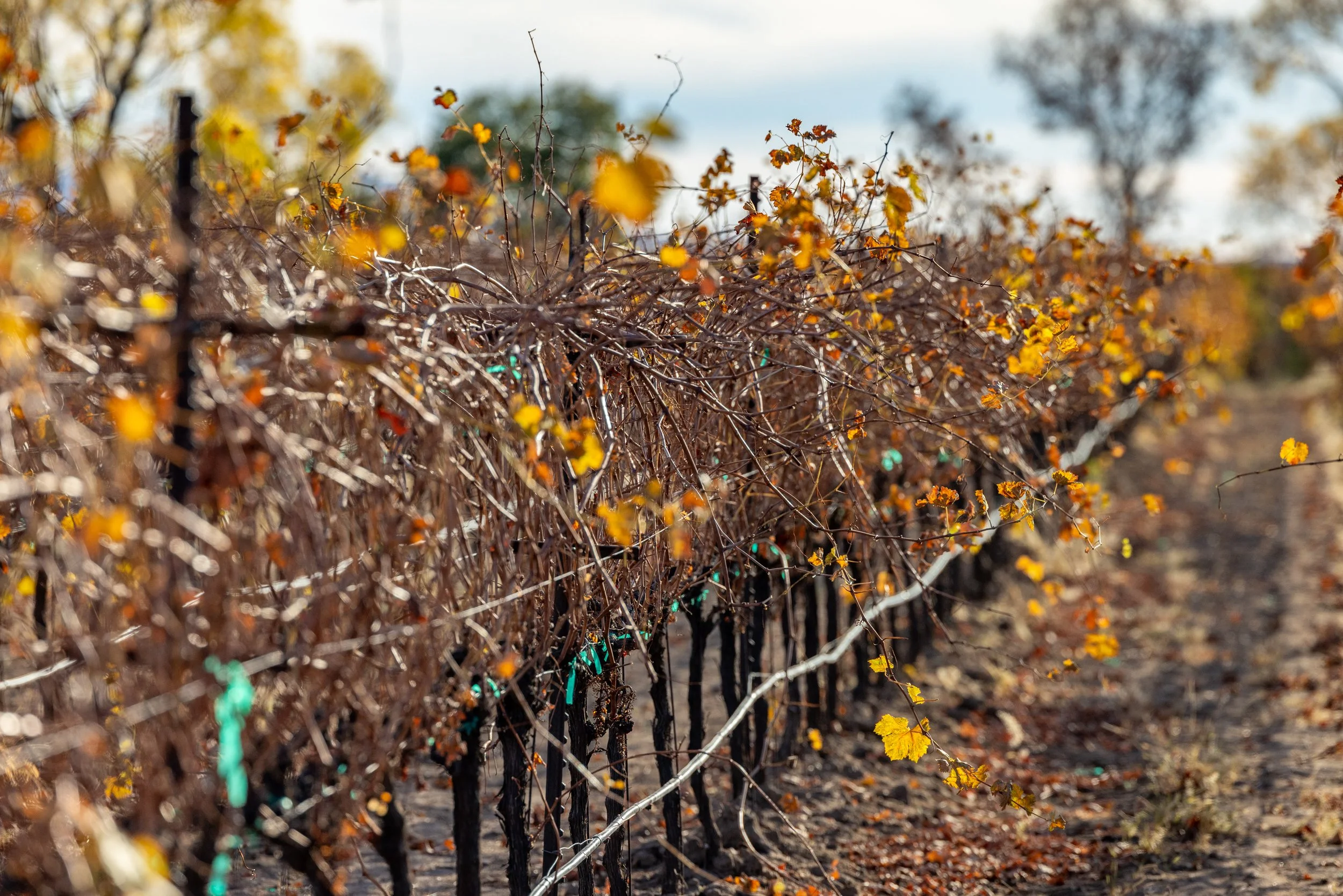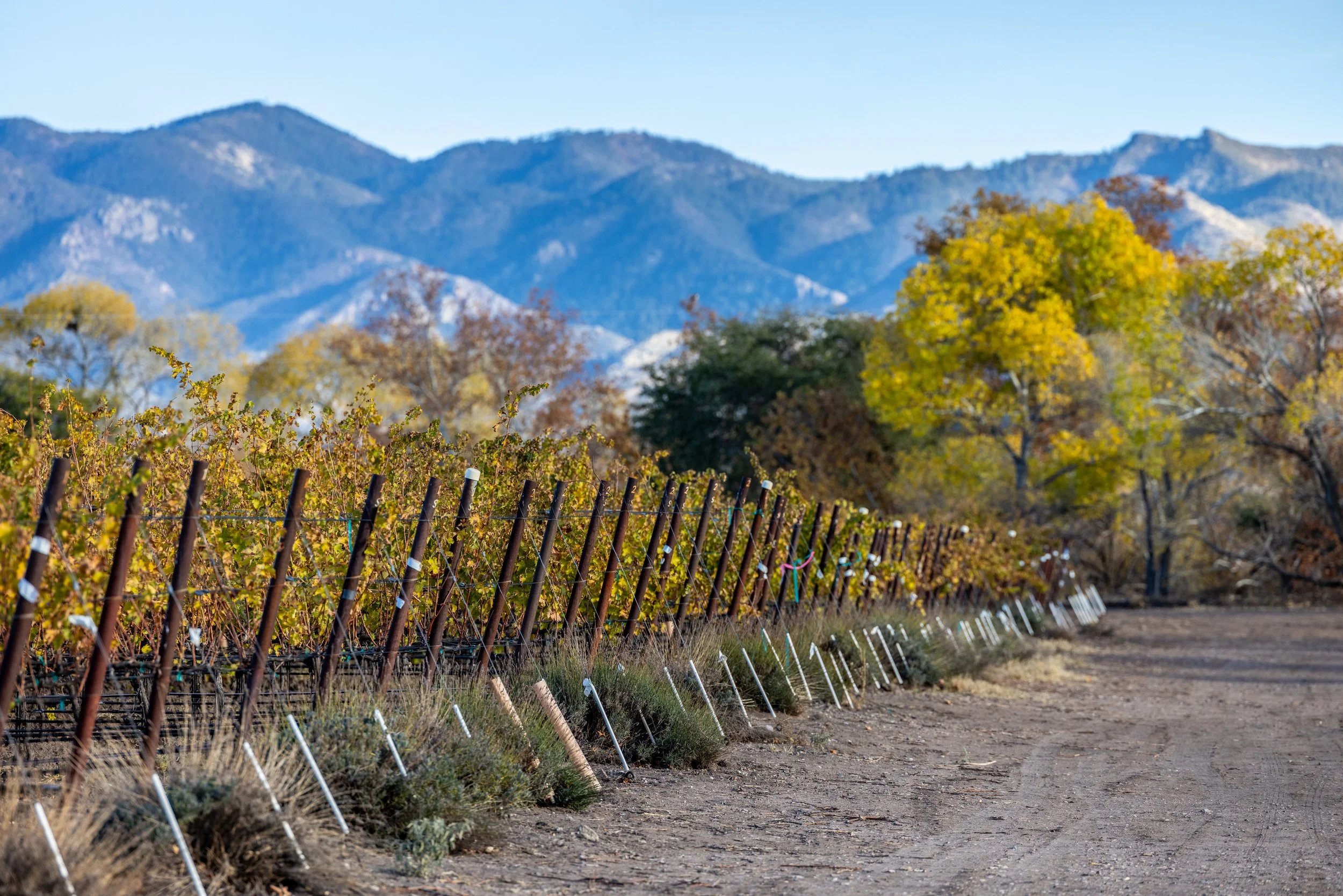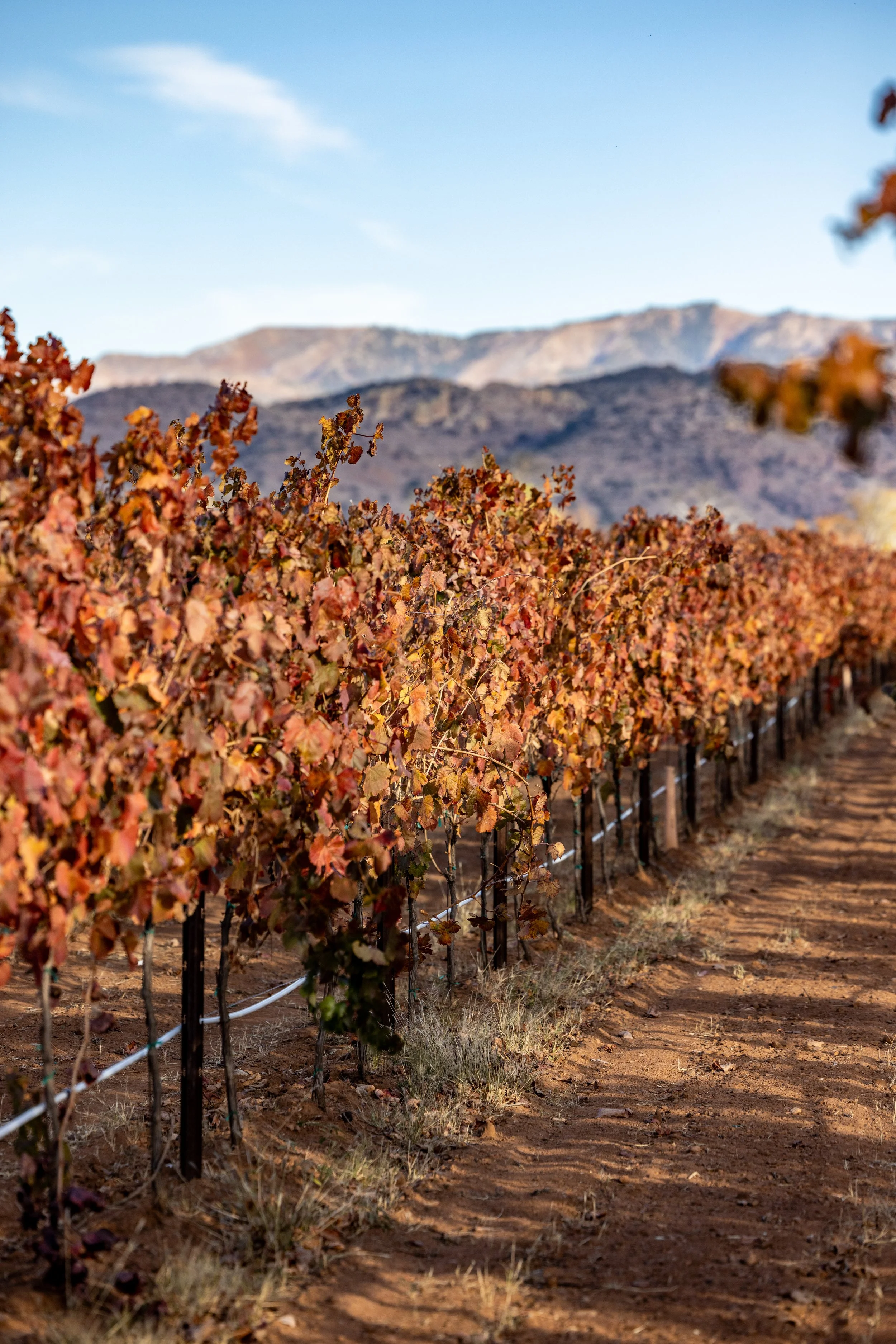Aridus Estate Vineyards
When We First Walked On This Property We Could Feel a Different Kind of Energy.
The light over the mountains, the sound of the babbling creek, and the smell of fresh air filtered through the Arizona oak trees at 5,200 feet - where do I sign? We found the perfect spot.
Now we need to do our homework and research. The first thing was to install a weather station. We soon learned that a lot of river rock is buried underneath, and installing the weather station pole with a shovel wasn’t going to happen.
Because there is a dramatic change in soil color across the creek, we set up soil sample studies. Everything was evaluated and confirmed, that the soil was perfect for growing grapes. However we did discover a section on the north side that contained large amount of salt deposits. How did it get there? No one knows.
We started planting our whites in 2015, and was completed that year. We had our first estate harvest in 2017. The reds continued to be planted from 2016 until 2020. Our first harvest of reds was our estate Cabernet Sauvignon in 2019, and more will be coming online each year.
My Grandfather was a nursery/grounds keeper for a castle in Scotland, and I hope I have inherited his green thumb.
Backgrounder:
Grape Growing in the Desert.
Aridus Estate Vineyards:
Nestled in the exquisite southeastern region of Arizona, just 45 miles away from the town of Willcox, lies a gem that captivates wine enthusiasts and nature lovers alike - a sprawling 40-acre estate vineyard. This picturesque sanctuary, located at 10250 East Turkey Creek Road in Pearce, showcases the harmonious marriage of natural beauty and viticultural excellence. With its serene ambiance and breathtaking views, this vineyard promises an idyllic setting for those seeking a slice of tranquility amidst the magnificent Arizona landscape. The 40 acres of undulating land are adorned with meticulously cultivated vines, each one nurtured with care by experienced hands. This hidden gem is a testament to the thriving wine culture in southeastern Arizona, where winemakers have embraced the challenge of cultivating vines in this distinctive microclimate. From the vibrant vineyard rows to the warm hospitality of its owners, this 40-acre sanctuary transcends the boundaries of a mere vineyard, immersing visitors in a captivating blend of natural beauty and viticultural excellence inviting them to savor the magic that is Pearce's 40-acre estate vineyard.
Appellation:
Currently, it does not belong to the Willcox AVA where Aridus and other vineyards are. They want to create a new wine region called Chiricahua Foothills, named after a nearby national monument spanning 11,985 acres.
The Chiricahua Name:
Pronounced CHIRR-i-KAH-wə, the name Chiricahua derives from a band of Apache Native Americans who resided in the Southwest, specifically in the region encompassing today's southeastern Arizona, southwestern New Mexico, and the mountain sanctuaries of the Sierra Madre in northern Mexico. Renowned figures in American history, such as Cochise and Geronimo, were among the most well-known names associated with the Apache tribe. Interestingly, the term "Chiricahua" is believed to be the Spanish interpretation of the Opata word "Chihuicahui" or "Chiguicagui," which translates to "mountain of the wild turkey," highlighting the significance of the Chiricahua Mountains to the tribal community.
History Of The Property:
The vast grazing land nourished countless generations of livestock, providing ample space and lush grasses for them to thrive. Each type of animal found solace in this haven, grazing harmoniously on the nutrient-rich soil. The legacy of this land continued as the sun set, a testament to the coexistence of man and beast.
Farming:
Primarily sustainable practices are at the heart of our approach, wherein we prioritize the use of organic alternatives whenever possible. Our commitment to sustainable farming methods extends to utilizing drip irrigation systems, which not only conserve water but also enhance efficiency in crop production. By constantly exploring innovative solutions and embracing environmentally friendly techniques, we strive to maintain a harmonious balance between agricultural productivity and the preservation of our precious natural resources.
Notable Harvest:
The 2017 harvest marks a momentous occasion for the estate vineyard as it unveils its inaugural offerings of white wines. With the inclusion of Sauvignon Blanc, Viognier, and Malvasia Bianca, the vineyard's portfolio expands to encompass a diverse range of flavors and profiles. These white varietals have been carefully cultivated and nurtured, showcasing the expertise and dedication of the vintner. As the first fruits of their labor are harvested, there is an air of anticipation and excitement surrounding these exceptional wines. From crisp and refreshing Sauvignon Blanc to the aromatic allure of Viognier and the delicately nuanced Malvasia Bianca, this harvest unveils a new chapter in the vineyard's legacy. The journey from grape to bottle has been a labor of love, and with each sip, wine enthusiasts are transported to the sun-kissed vines and rolling hills of the estate vineyard. Discover the essence of this remarkable harvest as these white wines offer a glimpse into the vineyard's terroir, inviting all to savor the unique flavors that have emerged from the 2017 harvest.
Grape most likely to succeed on the estate vineyard:
Which grape is unlikely to succeed? Unfortunately, my favorite grapes such as Chardonnay, Zinfandel, Pinot Noir, and other grapes that grow in cold climates are difficult to cultivate here. However, white grapes like Sauvignon Blanc, Viognier, and Malvasia Bianca thrive in this area. Most red grapes tend to do exceptionally well here, including Petite Sirah, Syrah, Malbec, Cabernet Sauvignon, Cabernet Franc, Petit Verdot, and Graciano.
Elevation:
The height is 5,200 feet, which is higher than the town of Willcox.
Weather:
The vineyard has very unpredictable weather, with temperatures ranging from extremely hot to cold. In the summer, it can get as hot as 100 degrees, but there are also strong winds, rain, hail (in July), and even snow. When it's time for harvesting the grapes (from July to September), the weather starts off hot and dry, with an average temperature of 95 degrees. However, there are occasional rainy periods in July, August, and September, which bring down the temperature and make the air more humid. The temperature during this time can vary between the 70s and 100s. Nights are cooler, with average temperatures between 45 and 55 degrees in the summer and during harvest.
Vineyard Layout:
The 40 acres are split by Turkey Creek, the biggest stream flowing down from the Chiricahua Foothills. On the "North Side," there are white types of grapes planted at an angle of 20-22 degrees in a north-south layout. On the "South Side," the grapes are planted in an east-west layout to let the strong winds pass through without harming the vines.
Local Landmarks:
There's a ranch close by that breeds and sets free wild turkeys. You'll also find Johnny Ringo's grave near the Vineyards. The Cochise Stronghold B&B offers both a glimpse into Chief Cochise and his Apache Warriors' past and the opportunity to go hiking in breathtaking surroundings.
Soil:
In the North Side, the color changes from dark grey to reddish brown. We planted 1,500 Cabernet Sauvignon vines here in May 2017. The soil is filled with river rocks, which had to be broken up and drilled to make holes big enough for the grapevines. On the South Side, the soil is completely different. It is a fertile, red sandy soil with river rocks..
Wildlife:
This area is home to a diverse range of animals, including fish, frogs, turtles, lizards, rattlesnakes, deer, mountain lions, black bears, foxes, and javalinas. It's teeming with reptiles, birds, insects, and both big and small predators and prey that wander about.
Irrigation:
This area is mainly for farming, so the property is designed to have enough water for irrigation. The property is divided in half by a creek called Turkey Creek. We might use water from the creek in the future, but for now, we have two wells.
Vine Spacing:
The vineyard on the North Side (for white grapes) is planted at a spacing of 8 feet by 4 feet, with vines growing on both sides. The vineyard on the South Side (for red grapes) is planted at a spacing of 10 feet by 5 feet. The spacing is different to make it easier to water the plants and access them.
The Blocks:
In the vineyard, there are signs that show the different types of grapes.
History of Planting:
The North Side was planted in 2015, and the South Side had Cabernet planted in 2017.
Specialized For This Terroir:
The vines on the North Side are from Nova Vine and Herrick Vines in California. They can withstand drought. We chose specific types and clones of grapes after consulting Arizona grape growers and considering our unique weather, soil, sun, and water conditions. The rootstock for the Southside vines was bought from New Mexico.
Harvesting:
Grapes are picked at midnight and taken to the winery early in the morning after a 45-minute journey from the Pearce vineyard to the Willcox winery.
Why Farm Grapes In Arizona:
Scott Dahmer, the owner, explains the factors that make their wines special: the hot days, cool nights, and the minerality of the soil. They believe that these conditions, along with the state's five C's (Climate, Cattle, Cotton, Citrus, and Copper), make Arizona a great place for growing grapes. The climate in southeastern Arizona is similar to Argentina, with semi-arid, desert-like conditions, very little rain, and average temperatures ranging from 90-100 degrees during the day and cooler nights in the 40s and 50s. Malbec and other Spanish grape varieties thrive in this region. Dahmer is confident that Arizona will become a well-known grape growing region and produce exceptional wines.


















